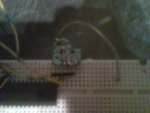i ripped a very small (postage stamp sized) 1.2ghz transmitter out of a wireless pinhole camera. I am using it to transmit serial data. When the data comes out of the receiver module, it is slightly noisy.
I've tried cleaning it by readadc then switch on output0 if the result is over a certain level. it works but only at a baudrate of 300 with is far off the 9600 i require
Here is the code i'm using to clean the signal
Symbol Signal = b0
Symbol CutOffLevel = 130
Symbol Out = 0
setfreq m8
Clean:
readadc 0,Signal
if Signal > CutOffLevel then
high Out
else
low Out
end if
goto Clean
What is the best way of cleaning a radio signal for speed?
I've tried cleaning it by readadc then switch on output0 if the result is over a certain level. it works but only at a baudrate of 300 with is far off the 9600 i require
Here is the code i'm using to clean the signal
Symbol Signal = b0
Symbol CutOffLevel = 130
Symbol Out = 0
setfreq m8
Clean:
readadc 0,Signal
if Signal > CutOffLevel then
high Out
else
low Out
end if
goto Clean
What is the best way of cleaning a radio signal for speed?


